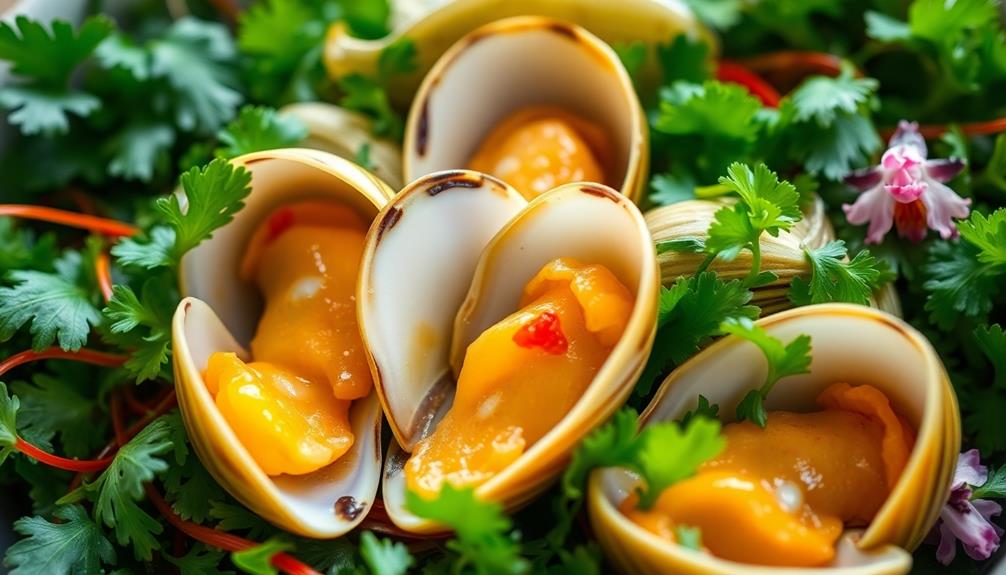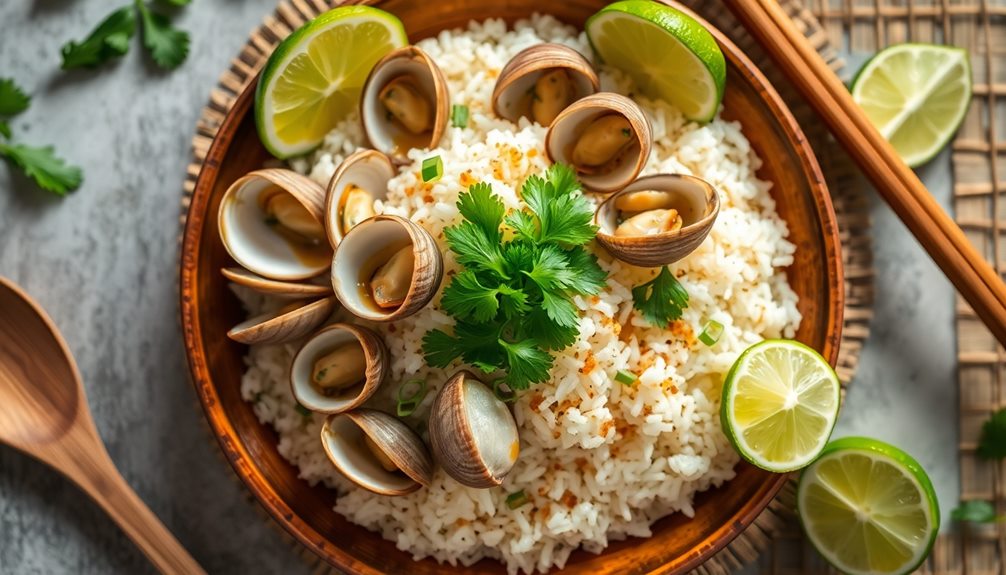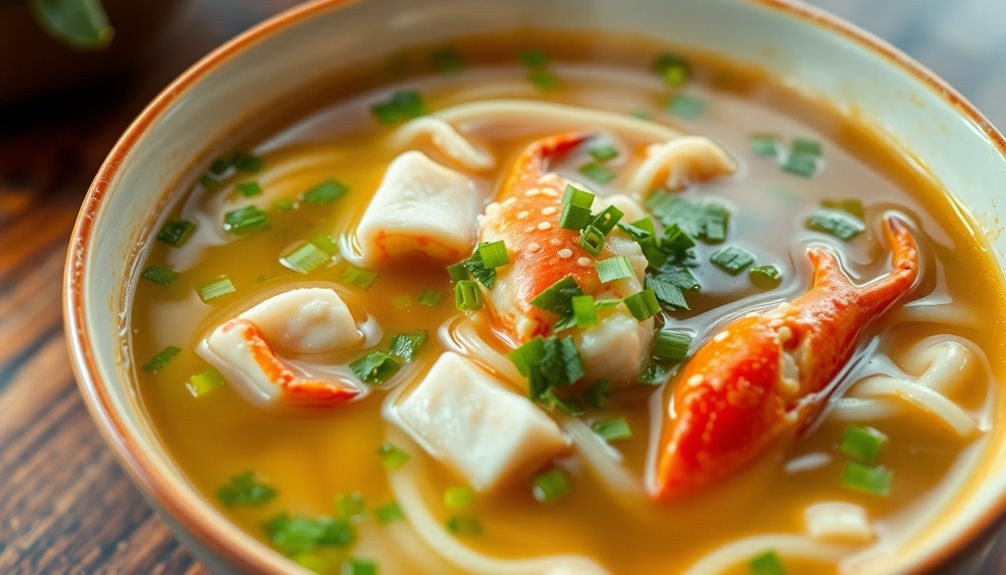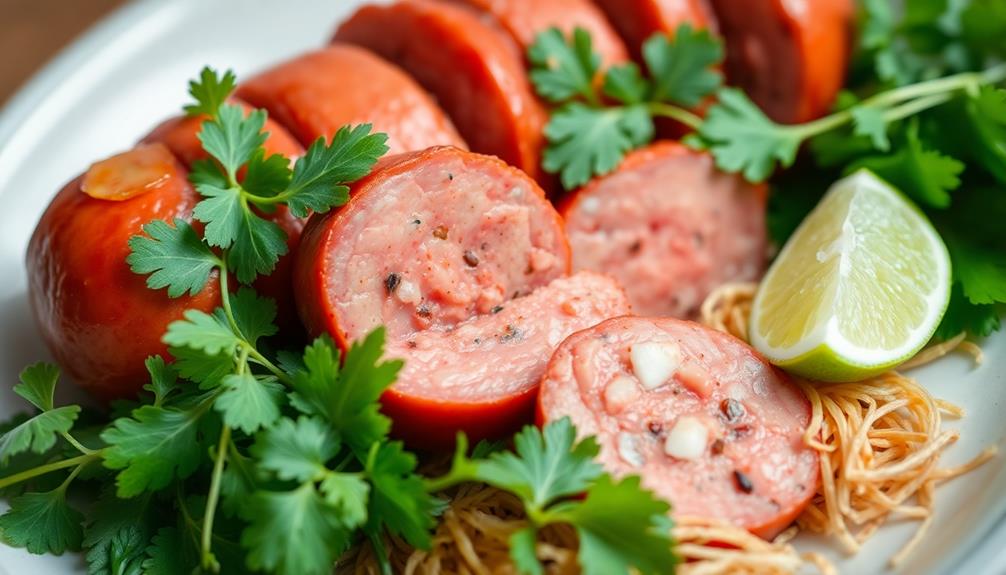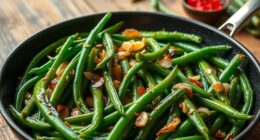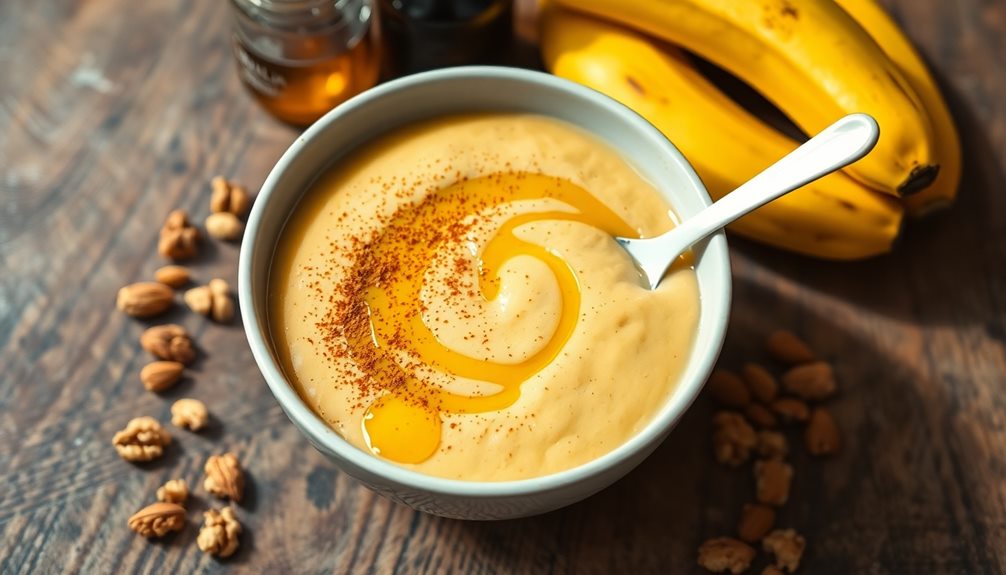Hailed as a distinctive Vietnamese culinary treasure, Giò Thủ, or Vietnamese head cheese, offers a bold and savory flavor profile that'll captivate your taste buds. With origins rooted in traditional preservation techniques and family recipes, this delicacy showcases the ingenuity of the Vietnamese people. Crafted by slowly simmering pigs' heads, Giò Thủ boasts a harmonious blend of rich textures and complex seasonings – it's a true delight for the senses. Served chilled with pickled veggies and rice, this dish celebrates the diversity of Vietnamese cuisine. If you're eager to explore more of this cultural culinary gem, keep reading to uncover its fascinating history and cooking secrets.
Key Takeaways
- Giò Thủ is a traditional Vietnamese delicacy made by simmering pig's head, showcasing the country's culinary ingenuity and bold flavors.
- Unique family recipes for Giò Thủ are often passed down through generations, reflecting the importance of tradition in Vietnamese cuisine.
- The dish is characterized by a harmonious blend of rich, savory flavors and a gelatinous texture derived from the use of pig's head.
- Giò Thủ is commonly served chilled, paired with pickled vegetables or fresh herbs, enhancing the overall dining experience.
- The preparation of Giò Thủ involves intricate techniques, such as soaking, simmering, and careful removal of gelatin, showcasing the culinary expertise of Vietnamese cooks.
History
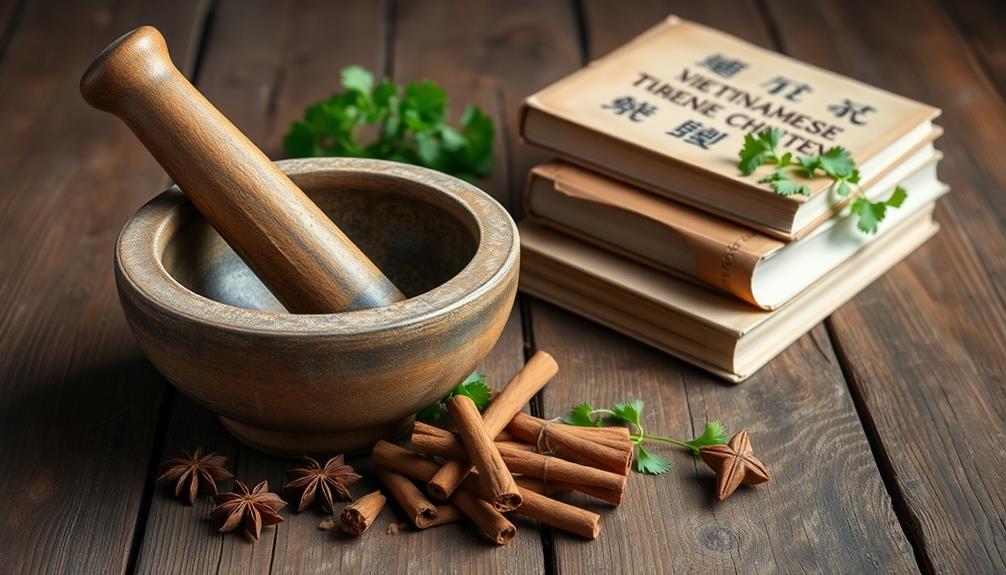
Although the exact origins of Vietnamese head cheese are unclear, it's believed to have evolved from traditional Vietnamese meat preservation techniques dating back centuries.
Over time, this age-old culinary tradition has become a beloved part of Vietnamese culture, with each family often having their own unique recipe passed down through generations.
The making of Vietnamese head cheese, known as giò thủ, is a true labor of love. It involves carefully selecting the freshest pork heads, slow-simmering them to extract the rich, gelatinous essence, and then expertly seasoning the mixture with an array of aromatic spices and herbs.
The result is a savory, bold, and distinctly Vietnamese delicacy that delights the senses.
Whether enjoyed as a snack, a side dish, or an integral part of a larger feast, Vietnamese head cheese is a testament to the ingenuity and culinary prowess of the Vietnamese people.
Its unique flavor and texture have earned it a beloved place in the hearts and homes of families across the country.
Recipe

Vietnamese Head Cheese is a unique and flavorful dish that showcases the versatility of using the entire animal. This savory terrine is made by slowly simmering the head of a pig, resulting in a gelatinous and delicious outcome.
The process of making Vietnamese Head Cheese requires patience, as the long cooking time is essential to extracting the maximum flavor and texture from the pork. However, the end result is well worth the effort, providing a rich and satisfying eating experience.
Ingredients:
- 1 pig's head, cleaned and split
- 1 onion, diced
- 3 cloves garlic, minced
- 2 tablespoons fish sauce
- 1 teaspoon ground black pepper
- 1 teaspoon salt
- Water, as needed
Instructions:
Place the split pig's head in a large pot and cover with water. Bring to a boil, then reduce heat and simmer for 4-6 hours, until the meat is extremely tender and falling off the bone. Skim any foam or impurities that rise to the surface during the cooking process.
Once the meat is cooked, remove the head from the pot and let it cool slightly. Carefully remove the meat from the bones, discarding any cartilage or tough pieces. Shred the meat and place it in a bowl. Add the diced onion, minced garlic, fish sauce, black pepper, and salt. Stir to combine.
When making Vietnamese Head Cheese, it's important to use a high-quality, fresh pork head. The long cooking time helps to break down the tough connective tissues, resulting in a silky, gelatinous texture.
Serve the Vietnamese Head Cheese chilled, either on its own or with a variety of accompaniments, such as pickled vegetables, fresh herbs, and rice.
Cooking Steps
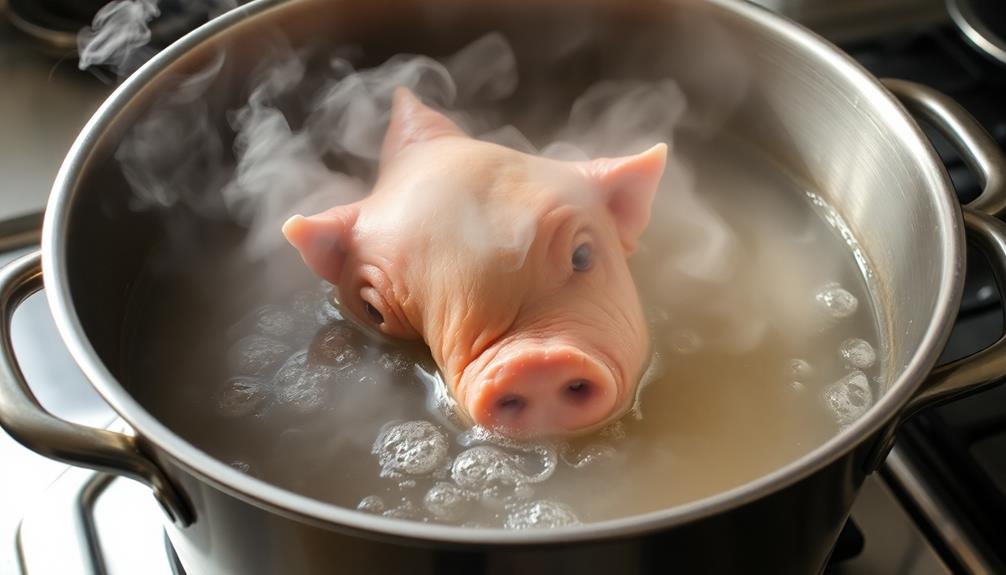
First, you'll need to soak the pigs' heads overnight to get them nice and tender.
Then, you'll simmer the heads until they're fall-off-the-bone soft.
Carefully remove the tasty gelatin, strain the broth, and slice up the meat to serve chilled – perfect for a Vietnamese-style celebration!
Step 1. Soak Pigs' Heads Overnight
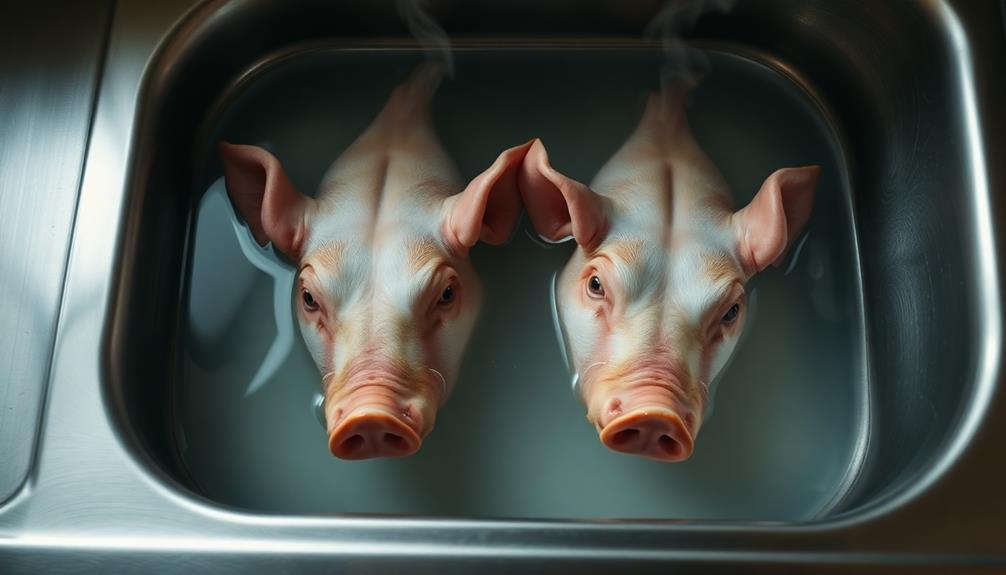
To prepare the pigs' heads for the Vietnamese head cheese, you'll need to soak them overnight. This important step helps to soften the tough skin and flesh, making it easier to work with later on.
Start by placing the pigs' heads in a large container or pot. Fill it with cold water, making sure the heads are fully submerged. Cover the container and let it sit at room temperature for 8-12 hours.
This slow soaking process will tenderize the meat and remove any impurities.
When you're ready to continue, drain the water and thoroughly rinse the pigs' heads under cool running water. Inspect them closely, removing any remaining hair or debris.
Now they're ready for the next step in creating your delicious Vietnamese head cheese! Get excited – the bold, savory flavors are just around the corner.
Step 2. Simmer Pigs' Heads Until Tender
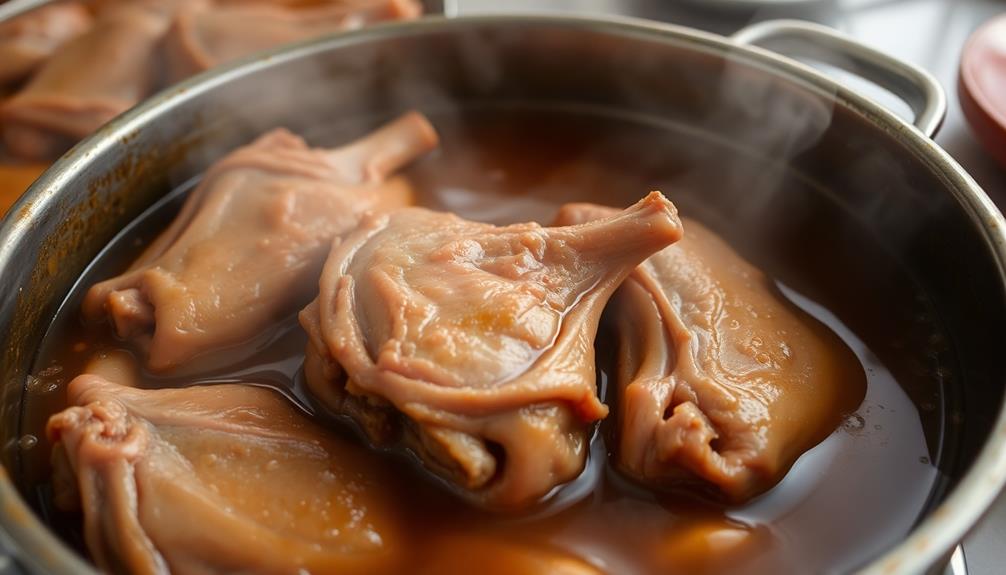
With the pigs' heads now thoroughly soaked and rinsed, it's time to start cooking them.
Grab your largest pot and transfer the heads into it. Pour in enough water to just cover the heads, then place the pot on the stove over high heat.
Bring the water to a boil, then reduce the heat to low. Let the heads simmer gently for 2-3 hours, until the meat is completely tender and falling off the bone.
You'll know they're ready when you can easily insert a fork into the meat.
During the simmering process, skim off any foam or impurities that rise to the surface. This will help keep the broth clear and clean.
Periodically check the water level, adding more as needed to ensure the heads stay submerged.
Once the pigs' heads are meltingly tender, it's time to move on to the next step – shredding the meat!
Get ready to create the base for your delicious Vietnamese head cheese.
Step 3. Remove Gelatin

After the pigs' heads have simmered and the meat has become tender, it's time to remove the gelatin.
Grab your tongs and carefully lift the cooked heads from the pot. Place them on a cutting board and let them cool slightly.
Once they're comfortable to handle, use your fingers to gently peel off the skin and fat. Underneath, you'll find the firm, gelatinous meat that will become the star of your Vietnamese head cheese.
Discard the skin and fat, then use a sharp knife to slice the meat into bite-sized pieces.
Transfer the sliced meat to a large bowl. This is where the magic happens! The natural gelatin in the pigs' heads will give your head cheese a wonderfully smooth and creamy texture.
Get ready to transform these humble ingredients into a true culinary delight!
Step 4. Strain Broth and Discard Solids
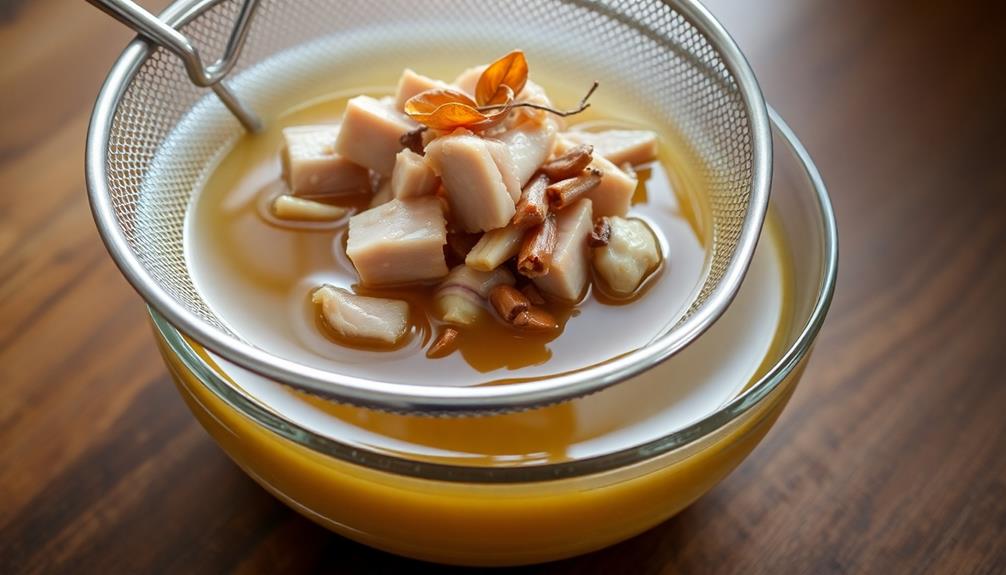
Now that the pigs' heads have simmered and the meat has been removed, it's time to strain the broth.
You'll need a fine-mesh sieve or cheesecloth to carefully separate the rich, flavorful liquid from the remaining solids.
Gently pour the broth through the sieve, taking care not to let any of the solid bits slip through.
Once the liquid has been strained, you can discard the leftover solids. They've already given up their best flavors to the broth, so there's no need to keep them.
With the broth now clear and ready to use, you can move on to the next step in creating your authentic Vietnamese head cheese.
This delicious dish is sure to impress your family and friends with its bold, savory flavors.
Get ready to enjoy the delightful texture and aroma of the strained broth as you continue your culinary journey.
Step 5. Slice and Serve Chilled

To assemble the head cheese, carefully slice the chilled meat into thin, evenly-sized pieces. This delicate process allows the unique flavors and textures of the giò thủ to shine.
Arrange the slices artfully on a serving platter, creating an eye-catching display.
Don't be afraid to get creative with your presentation! You can garnish the dish with fresh herbs, such as mint or cilantro, adding a pop of color and fresh aroma. For a festive touch, you might even scatter some roasted peanuts or crispy shallots over the top.
When ready to serve, encourage your guests to embrace the experience and dive in. The cool, gelatinous texture of the head cheese pairs beautifully with the aromatic bites.
Encourage everyone to savor each flavorful morsel, allowing the complex blend of spices and herbs to dance across their palates. This Vietnamese delicacy is sure to delight and impress all who try it!
Final Thoughts

Regardless of your culinary preferences, Vietnamese head cheese remains a distinctive and captivating delicacy. This bold and savory dish, known as Giò Thủ, is a true celebration of Vietnamese culture and ingenuity.
Crafted with care and attention to detail, each bite offers a harmonious blend of textures and flavors that will delight your senses.
Whether you're exploring new culinary adventures or revisiting a beloved classic, Giò Thủ is sure to leave a lasting impression. Serve it chilled, and let the flavors dance on your tongue, revealing the rich tapestry of Vietnamese cuisine.
Embrace the unique character of this dish, and you’ll discover a new appreciation for the diversity and artistry that Vietnamese food has to offer. This particular dish, with its perfect blend of savory and sweet flavors, showcases the mastery and complexity of Vietnamese cuisine. The Vietnamese caramelized fish recipe, passed down through generations, is a testament to the rich culinary tradition of the country. By exploring and savoring this dish, you’ll gain a deeper understanding of the cultural significance and culinary expertise that make Vietnamese food truly exceptional.
Frequently Asked Questions
Where Can I Purchase Vietnamese Head Cheese?
You can find Vietnamese head cheese, or "gio thu," at specialty Asian markets, Vietnamese grocery stores, or online retailers that sell authentic Vietnamese ingredients. Many Vietnamese communities will also have local producers who sell it directly.
How Long Does Vietnamese Head Cheese Last?
How long your Vietnamese head cheese lasts depends on how it's stored. If refrigerated, it can keep for up to 2 weeks. For longer storage, freeze it, and it'll stay fresh for several months.
Can I Make Vietnamese Head Cheese at Home?
Yes, you can make Vietnamese head cheese at home. It requires sourcing the right ingredients, following a traditional recipe, and taking the time to properly prepare and cook the dish. With some effort, you can enjoy homemade head cheese.
What Are the Health Benefits of Eating Vietnamese Head Cheese?
Eating Vietnamese head cheese can provide you with a range of health benefits. It's a good source of protein and essential minerals like iron, zinc, and selenium. Plus, it's low in carbs and may support gut health.
How Does Vietnamese Head Cheese Differ From Other Types of Head Cheese?
Compared to other types of head cheese, Vietnamese head cheese, or giò thủ, has a distinct flavor profile. It's more savory and bold, with added spices and herbs that give it a unique character you won't find in its Western counterparts.



